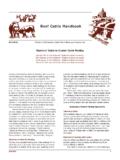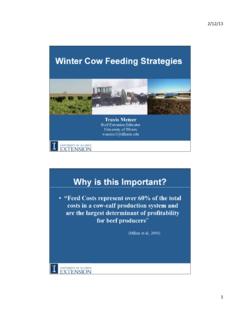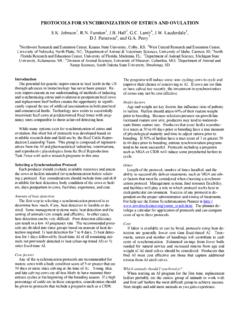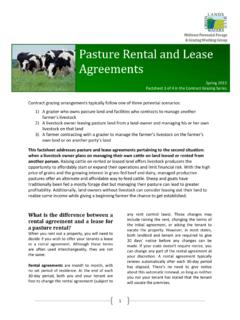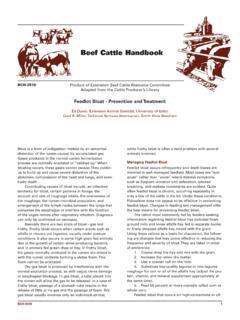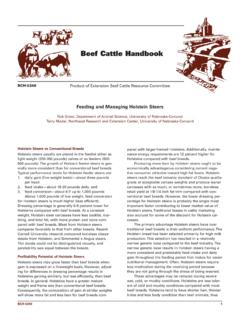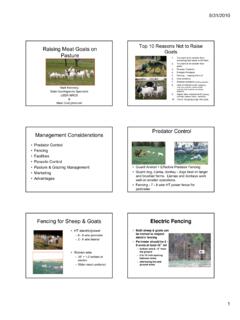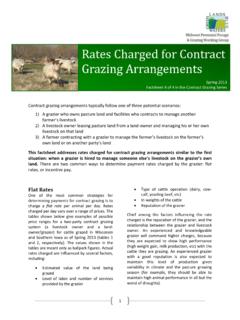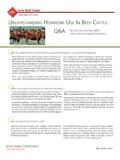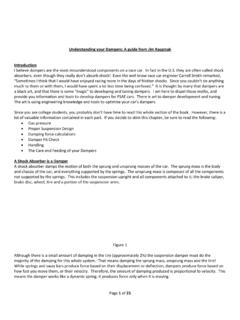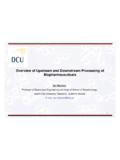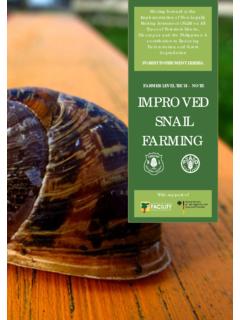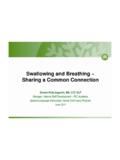Transcription of Nutrition, facilities, and management of the …
1 nutrition , facilities , and management of the Holstein steer Steven Rust Michigan State University An Iowa State alum and a North Dakota alum are standing next to each other in the men's room. The Iowa State grad finishes first and heads for the door. The North Dakota grad says, "At North Dakota State University, they teach us to wash our hands after we use the bathroom." Unimpressed, the Iowa State alum says, "At Iowa State University, they teach us not to pee on our hands." How are Holsteins different than native steers More docile Easily bored More pen maintenance Sort feed More bloats and metabolic problems More bullers More dust creation Wetter pens Suicidal tendencies /injuries Eng, 2005 CARCASS TRAITS WITHIN ESTIMATED BREED TYPES (NATIONAL BEEF QUALITY AUDIT 2000a) Breed type Trait Native Bos indicus Dairy USDA yield grade USDA quality gradeb 684f 662e 710g Adjusted fat thickness, in .51f .51f .31e Hot carcass weight, lb Longissimus muscle area, in2 Kidney, pelvic, and heart fat, % Marbling scorec 419f 381e 489g Overall maturityd 166 168 168 aMcKenna et al.
2 2002. JAS. 80:1212-1222 b600=Select00, 700=Choice00, 800=Prime00 c300=Slight00, 400=Small00, 500=Modest00 d100=A00, 200=B00 e,f,gMeans within a row lacking common superscript letter differ (P< ) Variables used in closeout comparisons In weight- 600 lb Shrunk out weight- 1250 lb ADG- lb Feed/gain- lb DMI/ lb gain Vet-med- $25/hd Yardage- $.40/hd/d Interest- 6% Trucking- $40/hd Weights control Purchase wt lb 500 600 Shrunk sale wt lb 1150 1131 Prices Delivered purchase price $/cwt $ $ Expected sale price $/cwt $ $ Gross Margin Gross revenue $/hd $1, Purchase cost $/hd $ Gross margin $/hd $ Performance Daily gain lb Feed/gain DM basis Out shrink % Death loss % Days on feed d 201 Feed costs Feed price (as-fed basis) $/ton Feed price (DM basis) $/ton $ Feed cost $/hd $ Other operating costs Yardage Rate $/hd/d $ $ Amount $/hd $ Veterinary & medication $/hd $ $ Marketing Sales commissions $/hd $ $ Transportation $/hd $ $ Beef Checkoff $/hd $ $ Options/Hedge cost $/hd Other input $/hd $ $ Death loss $/hd $ Operating cost subtotal $/hd $ Interest Interest rate % Interest on cattle $ Interest on feed $ Interest on other operating $ Total interest $/hd $ Total operating costs, excluding animal purchase $/hd $ Net return to labor, managment, & fixed costs Expected $/hd ($ ) Energy requirements NEgReq.
3 , Mcal/cwt ADG, lb 1) Feedlot 55-68 2) Backgrounding 45-55 3) Stocker 30-45 1) Blend of fast and slow digesting grain types 2) 5-15% dietary roughage 3) Processing is recommended when corn is expensive 4) Corn can be fed whole 5) Small grains need to be processed 6) Co-product feeds -hominy, potato products, distillers grains, brewers grains, food processing waste, out-of-condition human foodstuffs Roughage in feedlot rations Used as a management tool to keep cattle on feed An expensive ingredient in the diet Bulky Low energy Logistics of getting it into the ration Expensive Effects of corn silage level on profitability Corn silage level, % DM 15a 30a 45a 55a 30b Corn, % DM 40 25 10 0 0 ADG, lb Feed/gain Return to management , $/hd aRations contained 40% distiller s grain with soluble (DMB) bRation contained 65% distiller s grain with soluble (DMB) cAll rations contained 5% supplement dLinear relationship (P<.
4 01) for ADG and feed/gain eMeans from Nebraska study 2013 adjusted to a base of the standard animal- lb ADG and feed/gain ratio Nebraska, 2013 Performance summary of cattle fed different grain sources ADG, lb DMI, lb/d Feed/Gain Barley Corn Milo Oats Wheat abc(P<.05) Owens, 1995 Corn Oats Wheat Milo Barley Grains Faster Wheat Barley Rolled high moisture corn Steam flaked corn High moisture whole-shelled corn Slower Dry cracked corn Reconstituted milo Steam flaked milo Dry shelled corn Dry rolled milo Ground corn Effects of corn particle size on steer performance Whole Cracked Fine Ground 50:50 Whole: Cracked 50:50 Whole: Fine Ground ADG, lb * * DMI, lb/d Feed/Gain * * Nebraska, 1987 * P<.05 Whole-shelled Cracked Ear corn Ground corn EFFECT OF WHOLE AND DRY CORN ON CATTLE PERFORMANCE Whole Whole and dry rolled Dry rolled ADG, lb/d DMI, lb/d Feed/gain ab(P<.
5 05) Colorado Two trial summary of benefit of blending grains Blend Benefit, $/hd 50% whole:50% cracked 50% whole:50% fine 50% whole:50% rolled Average Disadvantages/challenges of earlage Requires 50% more storage Requires additional equipment (snapper head for chopper) Limited marketability in commercial markets Harvest moisture level window is narrow (35-40%) Proper ensilement is critical inch cut Proper packing Oxygen exclusion Beef produced per acre with different forms of corn Dry High moisture Corn/cob meal Earlage Earlage DM yield, lb/ac 75711 8123 (+ ) 9180 (+13) 9749 (+ ) 9749 (+ ) NEg of feed, Mcal/lb2 .70 .71 .62 .52 .57 (Rust estimate) NEg, Mcal/acre 5300 5768 5691 5069 5557 NEg,Mcal/hd/d3 Steer-days 418 455 449 408 447 Beef produced, lb/acre 1253 1363 1346 1223 1341 1 Assumed 160 bu/acre; 2 NRC, 1984 and Preston, 2010; 3 770 lb steer gaining Crude protein requirements A. Dietary levels 1) Feedlot to 13% 2) Receiving 12 to 14% B.
6 Effects of weight and rate of gain on protein requirements Weight, lb Protein, % ADG, lb Protein, % 300 500 700 900 1100 1300 Crude protein requirements C. Non-protein nitrogen usage-Urea 1) Can supply most of supplemental protein up to 12% CP in the diet 2) BCRTC of supplement from urea and from SBM 3) Can be added up to 1% of diet DM D. Bypass or escape protein 1) IUP levels, more concerned with untraditional feedstuffs -feather meal, heat-treated SBM, blood meal, meat and bone meal, 2) DIP levels, need to supply sufficient ruminally available nitrogen to optimize microbial efficiency -NPN, SBM, CSM Mineral and vitamin nutrition for cattle Formulate to meet NRC guidelines Feeding systems for Holstein steers High Plains system 250-350 lb steers are fed a single diet until harvest (85-92% concentrate) Two-phase feeding program Common amongst farmer-feeders Feed high roughage diets from 350-700 lb 40-60% corn silage 30-50% hay/haylage Pasture Finish on a 70-90% concentrate diet Feeding systems for Holstein steers Steer stuffer/self-feeder Feed whole corn and pellets Fill feeders once or twice a week More diligent in health check Approximately 30-40% of pens develop stall out Tends to work better with shorter feeding periods Lighter harvest weights Heavier in-weights The optimum system depend on feed availability and prices Advantages of various feeding systems High Plains Two-phase Steer stuffer Most predictable Utilize more roughage Best feed conversion efficiency Better health management More beef produced /acre Less labor Less metabolic problems Less manure Design a feeding program that fits your labor, land, facility and equipment resources Whole corn and pellet program vs a more conventional finish ration ADG.
7 Lb Feed/gain Trial Hay, 2 lb/ hd/d No roughage Hay, 2 lb/ hd/d No roughage 1 2 3 4 5 6 7 Average .64 .58 ( ) ( ) ADM Alliance nutrition Effects of placement of fleshy calves on pasture 1100 lb harvest wt 1200 lb harvest wt 1100 lb harvest wt 1200 lb harvest wt Grazing, # days 0 0 149 149 --- --- ADG, lb --- --- .86 --- --- Performance in feedyard DOF 236 278 158 200 --- --- ADG, lb .09 .002 DMI, lb/d .73 .17 Feed/gain .33 .0001 Ribeye area, in2 .36 .48 Quality grade .45 .39 Calc. YG .63 .001 Feeding heavy Holstein steers 72 Holstein steers Light- 71% Choice with a in2 ribeye area Heavy- 77% Choice with a in2 ribeye area Co-product feeds commonly fed in Michigan feedlots Animal fat Bakery waste Beet pulp Brewers grains Carrots Corn gluten feed Distiller s grain Hominy feed Husklage Potato co-products Sweet corn waste Wheat co-products Whey Animal fat Bakery waste Brewer s grain Beet pulp Carrots Corn gluten feed Distiller s grain Hominy feed Wheat bran Wheat middlings Potato co-products Sweet corn waste Husklage Whey Expected Change in ADG Level, %ADG, lbDryWet Probability Wet vs.
8 Dry .13 Level .64 Interaction .71 Expected Change in DM Intake Level, %DMI, lb/dDryWet Probability Wet vs. Dry .19 Level .17 Interaction .45 Expected Change in Feed Efficiency Level, %lb gain/lb DMIDryWet Probability Wet vs. Dry .001 Level .76 Interaction .70 Feeding recommendations for distiller s grain with soluble Protein source (1-3 lb/d) 6-15% Energy source (4-9 lb/d) 20-40%(maybe more) Mineral balance (Ca:P), Add limestone Ca:P> Does not replace all roughage sources Monitor S content of DGS Maximum allowable level = .4% Feeding 40 % DGS that has 1% S is risky!!!! Polioencephalomalacia (thiamine deficiency) Sulfur toxicity Feeding recommendations for distiller s grain with soluble Can be high in other macro- and micro-minerals (K, Na, Se, etc.) Prefer wet over dry DGS Value relative to corn (DM basis) Wet 110-120% Dry 100% Adjust nutrient management plans P Potential runoff Meta-analysis of feeding distiller s grain with soluble diets Control 30% DDGS 30% WDGS 30% MDGS 30% MDGS No.
9 Pens 66 350 85 85 DGS, $/ton as-is --- 250 74 125 92 Price relative to corn, % 90 80 80 60 ADG, lb Feed/gain Return to management , $/hd Comparison of low-fat versus full-fat distiller s grain Location/year #/trt Pens /trt DGS, % of diet DM DGS fat, % DM Diet fat, % diet DM Wt. gain, lb ADG, lb DMI, lb/d Feed/gain Kansas, 2008 203 8 0 0 302 Kansas, 2008 203 8 13 4 288 Kansas, 2008 204 8 13 12 307 Nebraska, 2011 24 4 0 0 406 Nebraska, 2011 24 4 35 408 Nebraska, 2011 24 4 35 445 Minnesota, 2011 16 16 0 0 515 Minnesota, 2011 16 16 35 498 Minnesota, 2011 16 16 35 517 Nebraska, 2013 45 5 0 0 586 Nebraska, 2013 45 5 40 646 Nebraska, 2013 45 5 40 657 Pair-wise test of difference from control ( ration without DGS) De-fatted Full fat Observed significance level .02 .19 .05 .04.
10 10 .30 Comparison of low-fat versus full-fat distiller s grain Number of studies With corn =9 Without corn =5 All studies fed 100-200 mg thiamine/hd/d Conventional diets had at least 80% corn DGS diets- 47-85 With corn = 47-78 Without corn = 48-85 Meta-analysis of studies comparing high levels of distiller s grain with soluble to conventional feedlot diets Predicted values from meta-analysis of feeding higher levels of distiller s grain with soluble (difference from conventional diet) ADG, lb DMI, lb/d F/G HCwt, lb Bfat, in. Marbling Choice, % YG 50 .07 .0 .0 55 .00 .0 60 .13 .00 .1 65 .18 .00 .1 70 .08 .1 75 .1 80 .0 Mean1 778 .48 522 78 ProbL .14 .27 .96 .99 .71 .16 .94 .43 ProbQ .14 .12 1 Control mean of all studies Predicted values from meta-analysis of feeding higher levels of distiller s grain with soluble without corn in the diet (difference from conventional diet) ADG, lb DMI, lb F/G HCwt, lb Bfat, in.
